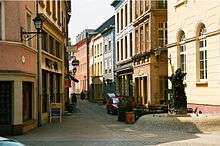Remich
Remich is a town in southeast Luxembourg with around 3,000 citizens. It, like Grevenmacher, is located on the left bank of the river Moselle, which makes up the border between Luxembourg and Germany.


Understand
After the withdrawal of Roman troops in the 5th century, the Roman settlement of Remacum turned gradually into Remich. It grew over time but got destroyed by Normans in 882. Fragments of the medieval fortifications, such as the Saint Nicolas gate, are still visible today. In 1687 most of the town's fortifications were demolished by the army of Louis XIV (of France). Various coats of arms and guild symbols can still be found on some houses in Remich.
Get in
By car
The N2 (Route de Remich), also known as E29, connects Luxembourg City and Remich. The N10 connects Schengen in the south to Grevenmacher and Wasserbillig, following the Moselle until the latter, after which it follows the Sauer or Sûre, connecting to Echternach, Diekirch, Ettelbruck, Vianden and eventually terminating near Clervaux. The N1 connects the aforementioned Grevenmacher and Wasserbillig to Luxembourg City.
By public transit
Coming from Germany, Remich can be reached through the station of Nennig in Germany, from which it is a 10-minute walk to Remich, crossing the bridge over the Moselle. The main hub for busses in Remich is the Gare Routière, from which bus 175 runs every hour to Luxembourg City. It leaves Luxembourg City from the train station (without passing through the city centre). Other busses are the 180 to Mondorf-les-Bains, 450 to Grevenmacher and 155 to Saarlouis in Germany. Line 185 stops in Remich, connecting Schengen and Mondorf-les-Bains.
Get around
The bicycle is the preferred mode of transport by tourists. Rentabike Miselerland is by far the most used service for renting bikes, having a handful of locations at which you can rent and return your bike located along the Moselle.
- 🌍 Rentabike Miselerland (Remich), Esplanade, ☎ +352 621 356 137.
See
- Fuesend Karneval is a three-day-long celebration of Carnaval, which is notable for its special events: Stréimännchen, the burning of a male effigy from the Moselle River bridge. This event symbolises the burning and doing away with winter. The second special event is the Buergbrennen bonfire that closes the celebration. The Fuesend Karneval also has a parade.
- 🌍 Musée A Possen, 1 Rue Aloyse Sandt, Bech-Kleinmacher, ☎ +352 23 69 73 53. Folklore, wine and toy museum.
Do
- Tour a wine cellar. Caves St. Martin (circa 1921) is known for their crémants. They offer a 45-minute tour of their man-made underground wine cellars (1 km); prices include a glass of crémant (6 euros) or one glass of crémant and one glass of Auxerrois Grand Premier Cru (7.50 euros).
Buy
Eat

- 🌍 Pavillon Desom, 49 Esplanade, ☎ +352 23 69 81 75.
- 🌍 Gandhi, 32 Rue de Macher, ☎ +352 26 66 48 51.
- 🌍 Brasserie-Restaurant Le Lion D'Or, 30 Quai de la Moselle, ☎ +352 26 66 43 20.
- 🌍 Um Scheff, 20 Quai de la Moselle, ☎ +352 26 37 87 58.
- 🌍 Restaurant-Auberge La Croisette, 4 Quai de la Moselle, ☎ +352 26 66 05 05.
- 🌍 Café / Restaurant Moselbrück, Zur Moselbrücke 15, Perl, ☎ +49 6866 150850.
- 🌍 Pavillon Desom, 49 Esplanade, ☎ +352 23 69 81 75.
- 🌍 Restaurant Pavillon Saint Martin, 53 Route de Stadtbredimus, ☎ +352 23 66 91 02.
Drink
- 🌍 Café Schumacher, 40 Rue de Macher, ☎ +352 23 66 94 90.
- 🌍 Réimecher Stuff, 30 Quai de la Moselle, ☎ +352 26 66 43 20.
- 🌍 Café Um Moart, 3 Place du Marché, ☎ +352 26 66 45 82.
Sleep
- 🌍 Hotel Saint-Nicolas, 31 Esplanade, ☎ +352 26 663. 4-star hotel with spa and restaurant located on the bank of the river Moselle. €111.
- 🌍 l'Esplanade, 5 Esplanade, ☎ +352 23 66 91 71. 3-star hotel €85.
- 🌍 Hotel Restaurant Ecluse, 29 Waistrooss, Stadtbredimus, ☎ +352 23 61 91 1.
- 🌍 Camping Mosella am Rothaus, Zur Moselbrücke 2a, Perl, ☎ +49 6866 510.
- 🌍 Hotel Villa Belle-Rive, 49 Route de Stadtbredimus, ☎ +352 27 07 56 77.
- 🌍 Camping Opa Schuler, Obermoselstraße 1, Palzem, ☎ +49 6583 678.